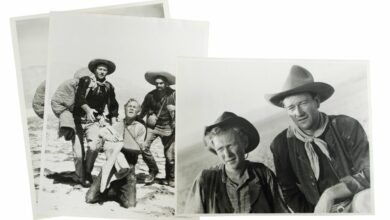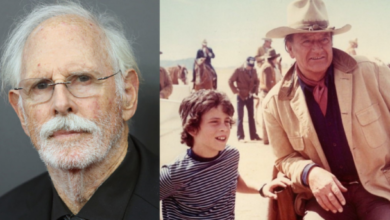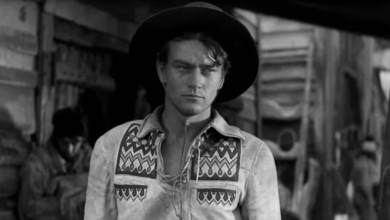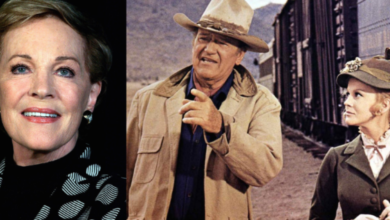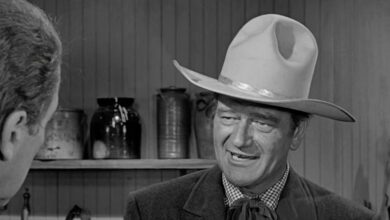True Grit: How The 2010 Movie Compares To The Book & John Wayne Version
The Coen Brothers' 2010 movie True Grit was the second film adaptation of Charles Portis' novel. Here's how all three versions compare.
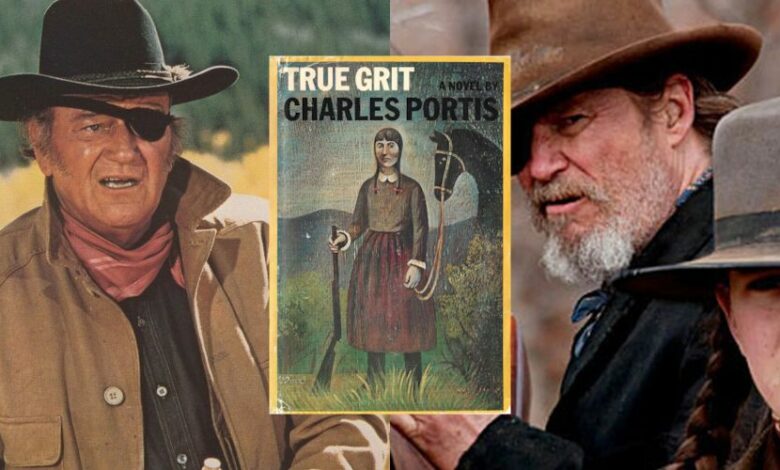
In the half-century since Charles Portis first conceived the ruffian tale of a young girl and a brazen, drunken US Marshal joining forces, there have been two film adaptations of True Grit – but how exactly do these versions of the story differentiate and coincide with the novelist’s original book? The first movie, directed by Henry Hathaway and written by Marguerite Roberts, came out in 1969, only one year after the novel first hit shelves. Starring Kim Darby, country singer Glen Campbell, and a young Robert Duvall, the film was also the only Academy Award winning performance delivered by the great “Duke,” John Wayne. The role would later become the host for another Oscar nomination when Jeff Bridges embodied the character in the Coen Brothers’ appropriately grittier adaptation of the novel. The Fargo directors’ version of True Grit starred Bridges alongside Hailee Steinfeld, Matt Damon, Josh Brolin, and Barry Pepper.
In all three cases, the story is launched by the brutal murder of honest man Frank Ross by the cowardly, thieving Tom Chaney. After the news ventures back to Yell County, Arkansas, Ross’ persistent daughter Mattie, opts to travel to Fort Smith and scrounge out what is happening in terms of an investigation. Whilst there, she learns that Chaney is believed to have fled into the Indian Territory with a gang of outlaws, out of the jurisdiction of the local sheriffs and officers. So, after inquiring about a US Marshal who commands a sense of “true grit,” she is led to the gruff door of Rooster Cogburn, who reluctantly takes her and an ambitious Texas Ranger named LaBeouf across the water and into the Indian Nation.
The story itself, catapulted by two feature adaptations as well as a John Wayne spinoff sequel (Rooster Cogburn), has become an integral fable of the Wild West – in literature and in film. Here’s how the fabric of True Grit matches and differs across each of its treasured mediums.
2010 Film Vs. Charles Portis’ Book

When Joel and Ethan Coen set out to make their version of True Grit, they did so with the intention not of remaking the John Wayne/Henry Hathaway classic, but of creating a more faithful adaptation to Charles Portis’ novel. Starting out on the wisdom of a Bible verse, Proverbs 28:1, they set the tone of their film: “The wicked flee when one pursueth.” While this may seem like the perfect prelude to the story, one whose villain initiates the plot by fleeing into the Indian nation, interestingly, that is only one half to the verse, coyly disguising the wrecking that is to come of him: “but the righteous are as bold as a lion.”
Though the 2010 movie was criticized by some for its typical revenge narrative, this biblical gentility allowed the Coen Brothers to tonally preserve Portis’ simple, quiet approach to dialogue. It’s fair to say that in the West, where literacy and education were not of the highest priority or quality (see John Ford’s The Man Who Shot Liberty Valance), imposing straightforward dialogue between the threesome of disjointed and disinterested colleagues is to be expected. But what the Coen Brothers and Portis are both doing is establishing a setting where words are minced, but thoughts are rampant. As Cogburn, Mattie, and LaBeouf embark on this journey together, the audience receives Mattie’s wonderings and observations through the narration – but at the same time, the sense of responsibility and protection manifesting themselves in both the US Marshal and the Texas Ranger are palpable, even if neither say it.
In terms of events, again, the Coen Brothers’ True Grit is more directly suited to staying accurate with the book. That being said, they did impart some of their quintessential and defining strangeness onto the film. For instance, that “Bear Man” scene was a Coen original. Also, during the triple hanging sequence, the Coens impart a bit of racial humor and horror. One of the men that is to be executed is an Indian; though all three are given the opportunity to offer some final words (the order of which is swapped, but the content is generally the same), the Indian’s final words are cut off by the dismissive executioner. In the book, all three men are given the opportunity to talk in full, but the Coen Brothers’ sense of dark comedy and social awareness comes through in this scene.
2010 Film Vs. 1969 Film

While there are tonal inconsistencies scattered throughout the 1969 film version of True Grit when compared to both the 1968 novel and the Coen Brothers’ 2010 adaptation (more on that later), there are also several differences between the events of the two films. For instance, the opening murder of Mattie’s father is portrayed differently in both movies. In the first version, Frank (played by John Pickard) is seen with his family, establishing who he is and his special relationship with his eldest daughter Mattie (Kim Darby). The audience also sees Tom Chaney (Jeff Corey) ride off with Ross, as Mattie rightfully expresses her skepticism towards the soon-to-be murderer’s character.
Though Portis’ book also displays these opening scenes in flashback, in the Coen Brothers’ movie, all of this 1969 exposition is cut out of the film. Instead, their version opens up on Frank’s corpse as Chaney (Brolin, who cannot be seen) gallops away on Ross’ horse. Mattie’s (Steinfeld) narration over the events matches that of the book’s opening chapter.
Similarly, the fate of the film’s two oldest justice seekers, Rooster Cogburn and LaBeouf, are identical in both the 2010 movie and the book, but altered in the 1969 film. In the older production, LaBeouf (Campbell) is struck on the back of the head by Chaney as he and Mattie await Rooster’s return to the top of the canyon. This happens again in the 2010 film, but while the Texas Ranger (Damon) is killed in his first onscreen presentation, he is left with a bad scar and a headache in the latter (Rooster and Mattie abandon him in need ). As for Cogburn, Wayne’s version survives until the end of the film, and later stars in the aforementioned romantic spinoff. Bridges’ does not get such a glorious send off; as seen in the film, the one-armed Mattie, now an old maid, ventures to see Cogburn for the first time since he saved her life all those years ago. By the time she gets to the carnival which he performs for, he has already died of old age and, more than likely, a notoriously sour lifestyle.
This isn’t to say that the Coen Brothers completely abandoned the Hathaway production when making their film. Scattered across the production are small tributes to the 1969 Oscar winner, most prominently in the film’s climatic shootout, as Jeff Bridges takes his reigns by the mouth and charges at the Lucky Ned Pepper gang with nothing but determination.
1969 Film Vs. Charles Portis

The fact that John Wayne was cast as Rooster Cogburn is both the 1969 True Grit‘s biggest strength and its greatest enemy – the latter referring to the film’s connection with Charles Portis’ novel. Wayne, aged 62 at the time of release, was a Hollywood institution; a symbol of masculinity, heroism, and American pride. Though his role in the Hathaway movie was considered to be a glowing triumph for the Duke, one that strayed away from the actor’s typical Western hero, time and a whole slew of murky, dark Westerns have corralled his performance as Cogburn back into the kennel of his iconic typecast.
Anchored on Wayne’s natural onscreen charisma, this first film version of True Grit is buoyed by a triumphant tone, one whose comedy is particularly punchy and whose heroics are particularly, well, heroic. Elmer Bertnstein’s memorable and dazzling score similarly articulates the tone, casting the crusaders off on their pursuit with an adventurous blast of trumpets, horns, and strings. Portis’ book does not incorporate such heroics. Cogburn, a US Marshall and a US drunk, is a dusty being, one whose tenacious and ignorant way of life gets in the way of his ingrained sense of duty; he is a redemptive character in all three versions, but the 1969 film, when compared to the book, is the weakest interpretation of such.
When put in comparison with the Coen Brothers’ production, the 1969 True Grit comes off as if it is playing the game safe. They may not have been the impression 20th century moviegoers received when viewing the critically acclaimed film, but with so many stark contrasts to the source novel, it is hard for the 1969 movie to shake off that idea.

